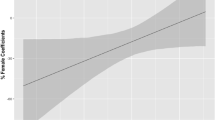Abstract
Since 2001 the National Science Foundation’s ADVANCE program has distributed over $130 million in grants to improve work climate, enhance professional success, and increase recruitment and retention of female faculty in STEM fields. The process by which each institution designs and implements these interventions is seldom studied, however. Using climate surveys, administrative records, and a difference-in-differences regression approach, we assessed whether exposure to the design and implementation process helps explain improvements in climate and retention during the early years of ADVANCE implementation. We found that departments wherein at least one faculty member participated in ADVANCE committee work experienced significant improvements in job satisfaction among female faculty members and significant reduction in turnover among female full professors, suggesting that the ADVANCE design process was itself an intervention.
Similar content being viewed by others
Notes
The Dean of Faculties office developed and administered the 2009 survey. Faculty members affiliated with ADVANCE refined and administered the survey in 2013.
A copy of the individual questions is available upon request to the corresponding author.
Although the College of Agriculture and Life Sciences contains a number of departments that are not STEM and therefore not eligible for NSF ADVANCE funding, the College of Agriculture and Life Sciences provided supplemental funding so that all of its departments were targeted.
Note that faculty rank is a year-specific variable in the data panel, so an individual could have been an assistant professor in 2004-2005 and an associate professor in 2005-2006. This person would have been in the assistant professor subsample in 2004-2005 and in the associate professor subsample in 2005-2006.
References
American Psychological Association (2015). Creating healthy workplaces. Retrieved from http://www.apaexcellence.org/resources/creatingahealthyworkplace/
Baez, B. (2000). Race-related service and faculty of color: Conceptualizing critical agency in academe. Higher Education, 39, 363–391.
Butts, M. M., Vandenberg, R. J., DeJoy, D. M., Schaffer, B. S., & Wilson, M. G. (2009). Individual reactions to high involvement work processes: Investigating the role of empowerment and perceived organizational support. Journal of Occupational Health Psychology, 14, 122–136.
Cammann, C., Fishman, M., Jenkins, G. D., & Klesh, J. R. (1983). Assessing the attitudes and perceptions of organizational members. In S. E. Seashore, E. E. Lawler III, P. H. Mirvis, & C. Cammann (Eds.), Assessing organizational change: A guide to methods, measures, and practices (pp. 71–138). New York, NY: Wiley.
Cotton, J. L., Vollrath, D. A., Froggatt, K. L., Lengnick-Hall, M. L., & Jennings, K. R. (1988). Employee participation: Diverse forms and different outcomes. Academy of Management Review, 13, 8–22.
Curtis, J.W. (2011). Persistent inequity: Gender and academic employment. Retrieved from https://www.aaup.org/NR/rdonlyres/08E023AB-E6D8-4DBD-99A0-24E5EB73A760/0/persistent_inequity.pdf
Demerouti, E., Bakker, A. B., Vardakou, I., & Kantas, A. (2003). The convergent validity of two burnout instruments: A multitrait-multimethod analysis. European Journal of Psychological Assessment, 18, 296–307.
Fjortoft, N. (1993, May). Factors predicting faculty commitment to the university. Paper presented at AIR Forum ’93: Forum of the Association of Institutional Research., Chicago, IL.
Grawitch, M. J., Trares, S., & Kohler, J. M. (2007). Healthy workplace practices and employee outcomes. International Journal of Stress Management, 14, 275–293.
Grawitch, M. J., Ledford, G. E., Jr., Ballard, D. W., & Barber, L. K. (2009). Leading the healthy workforce: The integral role of employee involvement. Consulting Psychology Journal: Practice and Research, 61, 122–135.
Griffin, K. A., Pifer, M. J., Humphrey, J. R., & Hazelwood, A. M. (2011). (Re)Defining departure: Exploring black professors’ experiences with and responses to racism and racial climate. American Journal of Education, 117, 495–526.
Gruber, J. (2005). Public finance and public policy. New York, NY: Worth.
Hart, J. (2016). Dissecting a gendered organization: Implications for career trajectories for mid-career faculty women in STEM. The Journal of Higher Education, 87, 605–634.
Institute of Medicine, National Academy of Sciences, & National Academy of Engineering. (2007). Beyond bias and barriers: Fulfilling the potential of women in academic science and engineering. Washington, DC: The National Academies Press.
Johnson, H. L. (2016). Pipelines, pathways, and institutional leadership: An update on the status of women in higher education. Washington, DC: American Council on Education. Retrieved from http://www.acenet.edu/news-room/Documents/Higher-Ed-Spotlight-Pipelines-Pathways-and-Institutional-Leadership-Status-of-Women.pdf
Mohr, R. D., & Zoghi, C. (2008). High-involvement work design and job satisfaction. Industrial and Labor Relations Review, 61, 275–296.
Ohmer, M. L. (2007). Citizen participation in neighborhood organizations and its relationship to volunteers’ self- and collective efficacy and sense of community. Social Work Research, 31, 109–120.
Ongori, H. (2009). Managing behind the scenes: A view point on employee empowerment. African Journal of Business Management, 3, 9–15.
Phipps, S. T. A., Prieto, L. C., & Ndinguri, E. N. (2013). Understanding the impact of employee involvement on organizational productivity: The moderating role of organizational commitment. Journal of Organizational Culture, Communications & Conflict, 17, 107–120.
Rosser, V. (2004). Faculty members’ intentions to leave: A national study on their worklife and satisfaction. Research in Higher Education, 45, 285–309.
Smart, J. C. (1990). A causal model of faculty turnover intentions. Research in Higher Education, 31, 405–424.
Welch, E.W., & Jha, Y. (2016). Network and perceptual determinants of satisfaction among science and engineering faculty in US research universities. Journal of Technology Transfer, 41, 290–328.
Wheeler, L. (1966). Toward a theory of behavioral contagion. Psychological Review, 73, 179–192.
Acknowledgements
This work was funded by the U.S. National Science Foundation under grants HRD-1008385. Any opinions, findings, and the conclusions or recommendations expressed in this material are those of the authors and do not necessarily reflect those of the National Science Foundation. The authors thank Kimberly Reeves, Rose Barlow, three anonymous reviewers, and the editors for their helpful feedback.
Author information
Authors and Affiliations
Corresponding author
Rights and permissions
About this article
Cite this article
Taylor, L.L., Beck, M.I., Lahey, J.N. et al. Reducing Inequality in Higher Education: The Link between Faculty Empowerment and Climate and Retention. Innov High Educ 42, 391–405 (2017). https://doi.org/10.1007/s10755-017-9391-1
Published:
Issue Date:
DOI: https://doi.org/10.1007/s10755-017-9391-1




